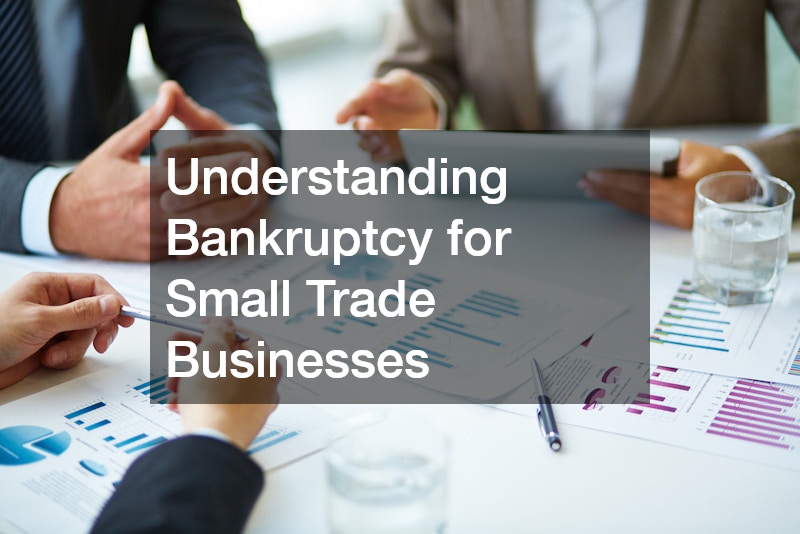
Introduction
Bankruptcy is often seen as a last resort—a red flag signaling a business in distress. However, it can also be the first step toward stability, restructuring, and even growth for many small, service-based trade businesses. Whether you operate a landscaping business, a propane delivery service, or work as a garage door installer, understanding the full impact of bankruptcy is essential, not just for your own survival, but for the well-being of those who do business with you.
When a business files for bankruptcy, the spotlight tends to shine on the debtor—the company or individual seeking relief. However, the ripple effects extend outward, impacting vendors awaiting payment, clients with unfinished projects, and subcontractors counting on continued work. These parties may suddenly find themselves in a financial gray zone, uncertain of how—or whether—they’ll recover what they’re owed.
Consider this: a tree removal business hired as a subcontractor for a large landscaping project could have already committed crews and equipment when the lead contractor files for bankruptcy. Or a propane business might have delivered thousands of gallons of fuel, only to learn that payment is on hold pending court proceedings. These are not just inconveniences—they’re potential threats to livelihoods.
This guide is designed to offer more than just legal definitions and dry procedures. It provides practical, strategic, and legal insights tailored specifically to small trade and service businesses. We’ll explore the types of bankruptcy most relevant to you, how filing impacts your relationships, and what steps both you and your partners can take to protect your operations and reputation. Importantly, we’ll highlight how the combined expertise of a local bankruptcy lawyer and a business development coach can be the key to not only surviving bankruptcy but also using it as a stepping stone toward a more resilient business model.
Whether you’re considering filing or are dealing with the fallout of someone else’s bankruptcy, this article offers a clear roadmap for what comes next. Let’s dive into what bankruptcy really means—for you, and for everyone doing business with you.
Understanding Bankruptcy for Small Trade Businesses

The concept of bankruptcy for small trade businesses can often seem overwhelming. Chapter 7, Chapter 11, and Chapter 13 bankruptcy provide different pathways, each with unique processes and implications. Chapter 7 involves liquidation, while Chapter 11 allows for reorganization, and Chapter 13 is typically about wage earners’ plans for individuals. These options differ significantly, especially in terms of how they allow you to manage ongoing business with you and repayment structures.
Among small trade businesses, Chapter 11 and Chapter 7 are typically more common. However, the choice often depends on specific business circumstances, legal advice from a local lawyer, and strategic planning. Chapter 11, for instance, might be suitable for a landscaping business looking to restructure and continue operations. In contrast, Chapter 7 might suit a smaller operation intent on starting fresh.
Each type affects your existing contracts, vendor agreements, and client payments differently. Misconceptions often cause panic, when in reality, bankruptcy doesn’t always spell the end, but can instead provide an opportunity for reorganization or a fresh start. It is essential to seek guidance from a local bankruptcy lawyer to navigate these waters effectively.
The Legal Impacts on Those Doing Business With You
When a business files for bankruptcy, it’s imperative to understand the legal obligations involved. The business has a duty to vendors, subcontractors, and clients, particularly concerning outstanding invoices and ongoing projects. During bankruptcy proceedings, these obligations must be managed carefully to avoid further complications.
The automatic stay is one of the most critical elements, as it puts a temporary halt to legal actions from creditors, including vendors and businesses owed payments. For instance, a propane business with unpaid deliveries must pause collection efforts but should stay informed of their legal rights and possible recovery plans.
Consider a tree removal business subcontracted for a paused landscaping project; knowing the intricacies of the stay can help anticipate the project’s resumption. Similarly, garage door installers awaiting payment need to strategize on how they will handle delayed contracts during the bankruptcy process. Legal advice ensures that you are navigating the complexities in a way that protects your interests.
How to Communicate Bankruptcy to Partners and Vendors

Transparent communication is paramount when informing partners and vendors about bankruptcy. It is crucial to engage with honesty and clarity, providing detailed explanations of how the situation may affect those doing business with you. This approach builds trust and may help mitigate the negative perceptions that often accompany bankruptcy filings.
Involving a local lawyer early on to help craft communication strategies can be invaluable. A lawyer or attorney can provide the legal framework and assist in creating messaging that accurately reflects the situation without causing unnecessary alarm. This preemptive action fosters goodwill and understanding among stakeholders.
For example, vendors and service providers involved with a leaf removal business may appreciate sample communication templates outlining the situation and next steps. The timing of these communications is crucial; notifying partners and vendors early and thoughtfully can maintain trust and leave the door open for future collaborations. Legal professionals can guide the best practices for these notifications to ensure compliance and maintain relationships.
How Your Bankruptcy Affects Others Financially
Understanding how bankruptcy affects others financially is key to managing relationships during this time. The moment a business files for bankruptcy, all financial interactions come under scrutiny, and clear communication becomes essential to avoid misunderstandings and preserve goodwill. Creditors—including vendors, subcontractors, and service providers—will naturally be concerned about their outstanding invoices and the likelihood of repayment. It’s crucial to clarify how these parties fit into the legal framework of bankruptcy and what they can realistically expect.
Secured creditors, such as lenders who have collateral backing their loans, tend to have their claims prioritized. For example, a bank that finances heavy machinery or vehicles for a trade business would typically have the right to repossess the equipment or receive payment from the sale. Unsecured creditors, on the other hand—those with no collateral backing their claims—face significantly greater risk. This includes suppliers, contract laborers, and even some utility providers. In many cases, unsecured creditors receive only a fraction of what they’re owed, if anything at all, depending on the assets available in the bankruptcy estate and the structure of the repayment plan.
Vendors and subcontractors affected by the bankruptcy may have several options. Filing a proof of claim with the bankruptcy court is a basic but essential step in seeking repayment. In more complex cases, particularly when significant sums or assets are involved, hiring legal representation to negotiate or litigate for recovery may be warranted. Others may opt to write off the outstanding amount as bad debt—a decision that can carry tax implications and affect future business planning.
The Role of Legal Professionals in Managing Bankruptcy

Legal professionals play an indispensable role in managing bankruptcy. Differentiating amongst a lawyer, attorneys, local lawyer, and local bankruptcy lawyer, is essential to know when you need specific expertise. Each offers distinct skills and knowledge suited to various facets of legal management during bankruptcy.
Working with a local bankruptcy lawyer provides advantages since they understand state-specific nuances and guide you through court filings, stakeholder disputes, and business restructuring plans. Their local expertise ensures compliance with varying state laws and business practices.
The benefits extend beyond your business, as having legal representation for your vendors and partners can aid in navigating these turbulent times. With proper legal advice, companies with which you conduct business may also comprehend their rights and ways to safeguard their financial interests. Engaging legal minds ensures all parties move forward with informed perspectives and strategies.
Strategic Planning With a Business Development Coach
Alongside legal professionals, a business development coach aids in pivoting post-bankruptcy. They offer actionable strategies such as revenue stream diversification and service bundling for stability, which is essential for a successful revival after financial difficulties. This support ensures businesses maintain integrity and market presence after declaring bankruptcy.
For instance, tree removal businesses might consider bundling services with landscaping to secure more consistent work. Coaches can also assist in crafting contracts with terms that protect against future risks. Strategic foresight helps businesses transform challenges into growth opportunities, enhancing resilience.
Rebuilding credibility with vendors and customers is a primary goal post-bankruptcy. By developing new services and maintaining open communication channels, business owners can restore trust and engage partners in long-term success. A business development coach’s expertise is indispensable for crafting a roadmap to recovery and prosperity.
Industry-Specific Advice: What Bankruptcy Looks Like in Your Line of Work

Navigating bankruptcy varies greatly across different industries. For instance, in a landscaping business, seasonal cash flow complicates the particulars of bankruptcy, requiring specialized advice. These businesses often rely heavily on peak-season earnings to carry them through leaner months. When filing for bankruptcy, the court and creditors may not fully appreciate this cyclical revenue model, potentially leading to unrealistic repayment plans or restructuring proposals. Therefore, accurate financial forecasting and clear documentation of seasonal trends are crucial in communicating your business’s operational reality.
A tree removal business, often equipment-heavy and liability-prone, faces unique vulnerabilities. Expensive machinery, such as bucket trucks and stump grinders, is typically financed and can become a point of contention during bankruptcy proceedings. Decisions around reaffirming or surrendering these assets must be made with an eye toward maintaining core service capabilities while reducing financial burden. Additionally, insurance obligations and potential injury claims must be factored into the equation, as bankruptcy does not necessarily shield the business from all types of liabilities, particularly those involving personal injury or negligence.
Similarly, a propane business may deal with regulatory compliance issues amid bankruptcy proceedings. The storage and transportation of hazardous materials are heavily regulated at both the state and federal levels. Suppose a propane business files for bankruptcy, its ability to maintain permits and comply with safety standards may be threatened, especially if cash flow interruptions delay maintenance or required inspections. In such cases, legal and operational strategies must be closely aligned to ensure continued compliance and avoid penalties or shutdowns that could worsen financial distress.
Conclusion & Next Steps
Facing bankruptcy doesn’t need to be a solitary journey. For many small trade businesses—whether you operate a propane delivery route, run a landscaping crew, or manage a team of garage door installers—the prospect of financial collapse can feel isolating and overwhelming. But you don’t have to go alone to it. With the right support from a local lawyer and a seasoned business development coach, bankruptcy can become a turning point rather than a dead end.
These professionals serve as more than just advisors—they become your frontline allies in restructuring your business and protecting the people who do business with you. A local bankruptcy lawyer brings a deep understanding of state-specific laws, court procedures, and creditor negotiations, guiding you through the legal maze with clarity and confidence. Meanwhile, a business coach helps you rebuild strategically, focusing on market positioning, operational efficiency, and long-term sustainability.
The ripple effects of bankruptcy are real, and they reach far beyond your own bottom line. Vendors who depend on your payments, subcontractors with open contracts, and clients with pending services all have stakes in your recovery. That’s why comprehensive planning and clear communication aren’t just best practices—they’re necessities. With proper legal and business guidance, you can mitigate the fallout, protect those doing business with you, and maintain your reputation in the community.
It’s also important to remember that bankruptcy is not synonymous with failure. In many cases, it represents an honest reevaluation of your financial structure and a legal opportunity to reset. However, success in this phase depends on being proactive, not reactive.
If you’re even thinking about filing, don’t wait for things to spiral. Reach out to a local bankruptcy lawyer immediately to understand your rights, risks, and options. Start conversations with key vendors and clients to manage expectations and preserve valuable relationships. Map out your path forward with input from a business development coach who can help translate legal breathing room into operational recovery.
Bankruptcy, when managed wisely, can be the first chapter of your comeback story. Establishing a clear, informed plan and engaging trusted professionals are the first steps to overcoming financial adversity—and unlocking a more resilient, future-ready business model.

